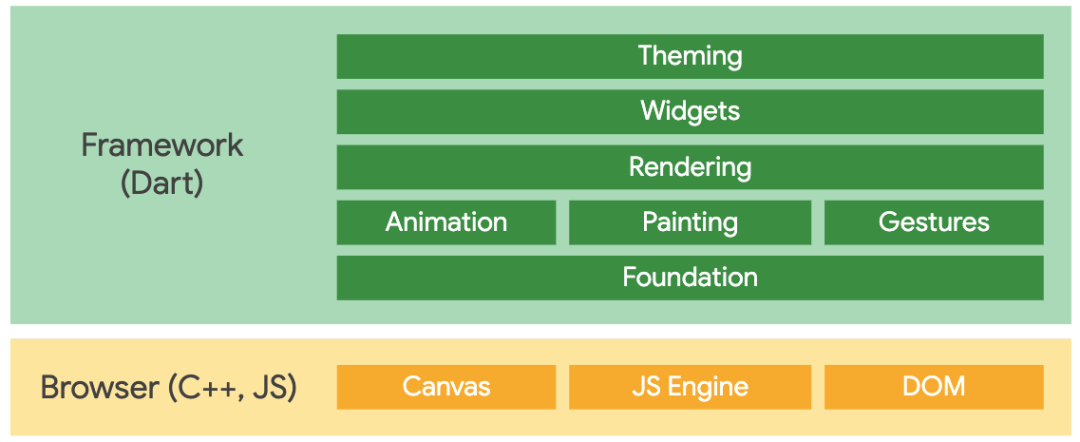最爱折腾的就是前端工程师了,从 jQuery 折腾到 AngularJs,再折腾到 Vue、React。最爱跨屏的也是前端工程师,从 phonegap,折腾到 React Native,这不又折腾到了 Flutter。
图啥?
低成本地为用户带来更优秀的用户体验。
目前来说Flutter可能是其中最优秀的一种方案了。
Flutter 是什么?
Flutter is Google’s UI toolkit for building beautiful, natively compiled applications for mobile, web, and desktop from a single codebase.
Flutter是由原 Google Chrome 团队成员,利用 Chrome 2D 渲染引擎,然后精简 CSS 布局演变而来。
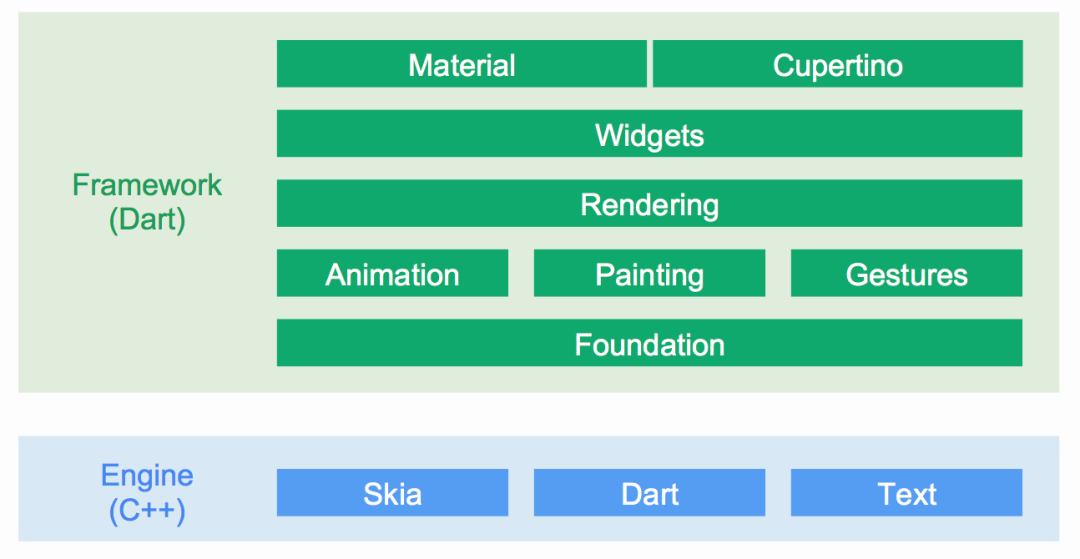
或者更详细的版本

- Flutter 在各个原生的平台中,使用自己的 C++的引擎渲染界面,没有使用 webview,也不像 RN、NativeScript 一样使用系统的组件。简单来说平台只是给 Flutter 提供一个画布。
- 界面使用 Dart 语言开发,貌似唯一支持 JIT,和 AOT 模式的强类型语言。
- 写法非常的现代,声明式,组件化,Composition > inheritance,响应式……就是现在前端流行的这一套 😄
- 一套代码搞定所有平台。
Flutter 为什么快?Flutter 相比 RN 的优势在哪里?
从架构中实际上已经能看出 Flutter 为什么快,至少相比之前的当红炸子鸡 React Native 快的原因了。
- Skia 引擎,Chrome, Chrome OS,Android,Firefox,Firefox OS 都以此作为渲染引擎。
- Dart 语言可以 AOT 编译成 ARM Code,让布局以及业务代码运行的最快,而且 Dart 的 GC 针对 Flutter 频繁销毁创建 Widget 做了专门的优化。
- CSS 的的子集 Flex like 的布局方式,保留强大表现能力的同时,也保留了性能。
- Flutter 业务书写的 Widget 在渲染之前 diff 转化成 Render Object,对,就像 React 中的 Virtual DOM,以此来确保开发体验和性能。
而相比 React Native:
- RN 使用 JavaScript 来运行业务代码,然后 JS Bridge 的方式调用平台相关组件,性能比有损失,甚至平台不同 js 引擎都不一样。
- RN 使用平台组件,行为一致性会有打折,或者说,开发者需要处理更多平台相关的问题。
而具体两者的性能测试,可以看这里,结论是 Flutter,在 CPU,FPS,内存稳定上均优于 ReactNative。
Dart 语言
在开始 Flutter 之前,我们需要先了解下 Dart 语言……
Dart 是由 Google 开发,最初是想作为 JavaScript 替代语言,但是失败沉寂之后,作为 Flutter 独有开发语言又焕发了第二春 😂。
实际上即使到了 2.0,Dart 语法和 JavaScriptFlutter非常的相像。单线程,Event Loop……
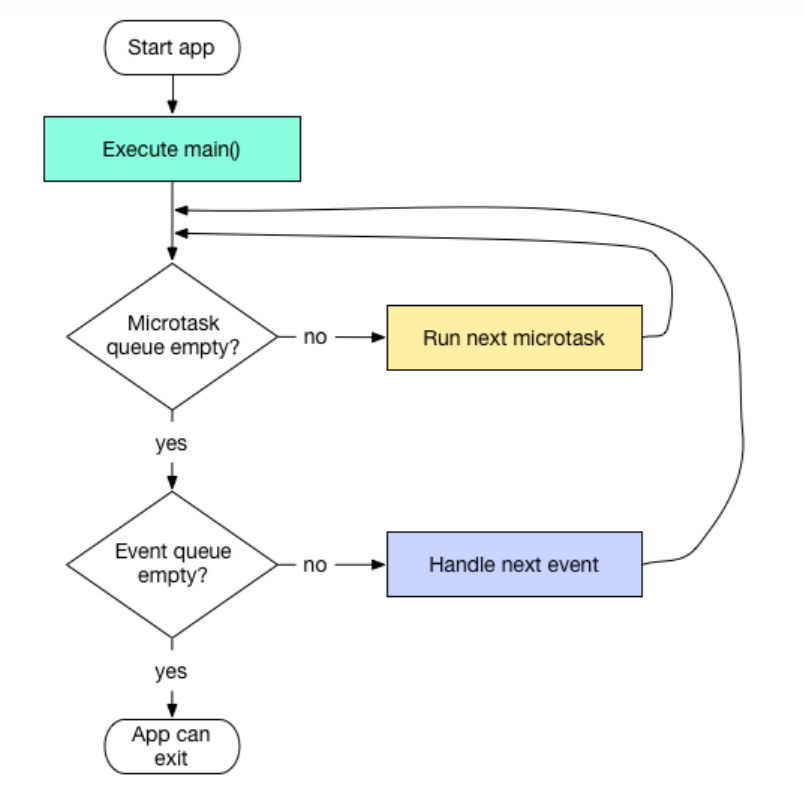
当然作为一篇写给前端工程师的教程,我在这里只想写写 JavaScript 中暂时没有的,Dart 中更为省心,也更“甜”的东西。
- 不会飘的this
- 强类型,当然前端现在有了 TypeScript 😬
- 强大方便的操作符号:
- ?. 方便安全的foo?.bar取值,如果 foo 为null,那么取值为null
- ?? condition ? expr1 : expr2 可以简写为expr1 ?? expr2
- =和其他符号的组合: *=、~/=、&=、|= ……
- 级联操作符(Cascade notation ..)
- // 想想这样省了多少变量声明
- querySelect('#button')
- ..text ="Confirm"
- ..classes.add('important')
- ..onClick.listen((e) => window.alert('Confirmed'))
甚至可以重写操作符
- class Vector {
- final int x, y;
- Vector(this.x, this.y);
- Vector operator +(Vector v) => Vector(x + v.x, y + v.y);
- Vector operator -(Vector v) => Vector(x - v.x, y - v.y);
- // Operator == and hashCode not shown. For details, see note below.
- // ···
- }
- void main() {
- final v = Vector(2, 3);
- final w = Vector(2, 2);
- assert(v + w == Vector(4, 5));
- assert(v - w == Vector(0, 1));
- }
注:重写==,也需要重写 Object hashCodegetter
- class Person {
- final String firstName, lastName;
- Person(this.firstName, this.lastName);
- // Override hashCode using strategy from Effective Java,
- // Chapter 11.
- @override
- int get hashCode {
- int result = 17;
- result = 37 * result + firstName.hashCode;
- result = 37 * result + lastName.hashCode;
- return result;
- }
- // You should generally implement operator == if you
- // override hashCode.
- @override
- bool operator ==(dynamic other) {
- if (other is! Person) return false;
- Person person = other;
- return (person.firstName == firstName &&
- person.lastName == lastName);
- }
- }
- void main() {
- var p1 = Person('Bob', 'Smith');
- var p2 = Person('Bob', 'Smith');
- var p3 = 'not a person';
- assert(p1.hashCode == p2.hashCode);
- assert(p1 == p2);
- assert(p1 != p3);
- }
这点在 diff 对象的时候尤其有用。
lsolate
Dart 运行在独立隔离的 iSolate 中就类似 JavaScript 一样,单线程事件驱动,但是 Dart 也开放了创建其他 isolate,充分利用 CPU 的多和能力。
- loadData() async {
- // 通过spawn新建一个isolate,并绑定静态方法
- ReceivePort receivePort =ReceivePort();
- await Isolate.spawn(dataLoader, receivePort.sendPort);
- // 获取新isolate的监听port
- SendPort sendPort = await receivePort.first;
- // 调用sendReceive自定义方法
- List dataList = await sendReceive(sendPort, 'https://hicc.me/posts');
- print('dataList $dataList');
- }
- // isolate的绑定方法
- static dataLoader(SendPort sendPort) async{
- // 创建监听port,并将sendPort传给外界用来调用
- ReceivePort receivePort =ReceivePort();
- sendPort.send(receivePort.sendPort);
- // 监听外界调用
- await for (var msg in receivePort) {
- String requestURL =msg[0];
- SendPort callbackPort =msg[1];
- Client client = Client();
- Response response = await client.get(requestURL);
- List dataList = json.decode(response.body);
- // 回调返回值给调用者
- callbackPort.send(dataList);
- }
- }
- // 创建自己的监听port,并且向新isolate发送消息
- Future sendReceive(SendPort sendPort, String url) {
- ReceivePort receivePort =ReceivePort();
- sendPort.send([url, receivePort.sendPort]);
- // 接收到返回值,返回给调用者
- return receivePort.first;
- }
当然 Flutter 中封装了compute,可以方便的使用,譬如在其它 isolate 中解析大的 json。
Dart UI as Code
在这里单独提出来的意义在于,从 React 开始,到 Flutter,到最近的 Apple SwiftUI,Android Jetpack Compose 声明式组件写法越发流行,Web 前端使用 JSX 来让开发者更方便的书写,而 Flutter,SwiftUI 则直接从优化语言本身着手。
函数类的命名参数
- void test({@required int age,String name}) {
- print(name);
- print(age);
- }
- // 解决函数调用时候,参数不明确的问题
- test(name:"hicc",age: 30)
- // 这样对于组件的使用尤为方便
- class MyApp extends StatelessWidget {
- @override
- Widget build(BuildContext context) {
- return Scaffold(
- appBar: AppBar(),
- body: Container(),
- floatingActionButton:FloatingActionButton()
- );
- }
- }
大杀器:Collection If 和 Collection For
- // collection If
- Widget build(BuildContext context) {
- return Row(
- children: [
- IconButton(icon: Icon(Icons.menu)),
- Expanded(child: title),
- if (!isAndroid)
- IconButton(icon: Icon(Icons.search)),
- ],
- );
- }
- // Collect For
- var command = [
- engineDartPath,
- frontendServer,
- for (var root in fileSystemRoots) "--filesystem-root=$root",
- for (var entryPoint in entryPoints)
- if (fileExists("lib/$entryPoint.json")) "lib/$entryPoint",
- mainPath
- ];
更多 Dart 2.3 对此的优化看这里。
Flutter 怎么写
到这里终于到正题了,如果熟悉 web 前端,熟悉 React 的话,你会对下面要讲的异常的熟悉。
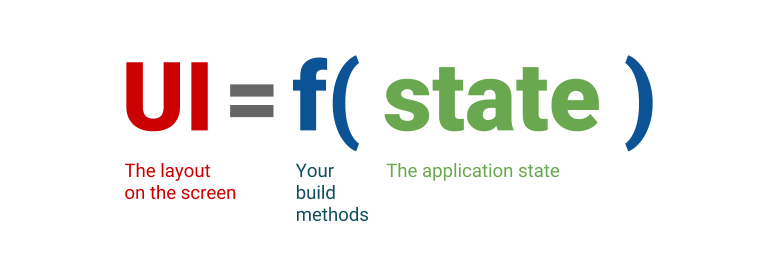
Flutter App 的一切从lib/main.dart文件的 main 函数开始:
- import 'package:flutter/material.dart';
- void main() => runApp(MyApp());
- class MyApp extends StatelessWidget {
- @override
- Widget build(BuildContext context) {
- return MaterialApp(
- title: 'Welcome to Flutter',
- home: Scaffold(
- appBar: AppBar(
- title: Text('Welcome to Flutter'),
- ),
- body: Center(
- child: Text('Hello World'),
- ),
- ),
- );
- }
- }
Dart 类 build 方法返回的便是 Widget,在 Flutter 中一切都是 Widget,包括但不限于
- 结构性元素,menu,button 等
- 样式类元素,font,color 等
- 布局类元素,padding,margin 等
- 导航
- 手势
Widget 是 Dart 中特殊的类,通过实例化(Dart 中new 是可选的)相互嵌套,你的这个 App 就是形如下图的一颗组件树(Dart 入口函数的概念,main.dart -> main())。
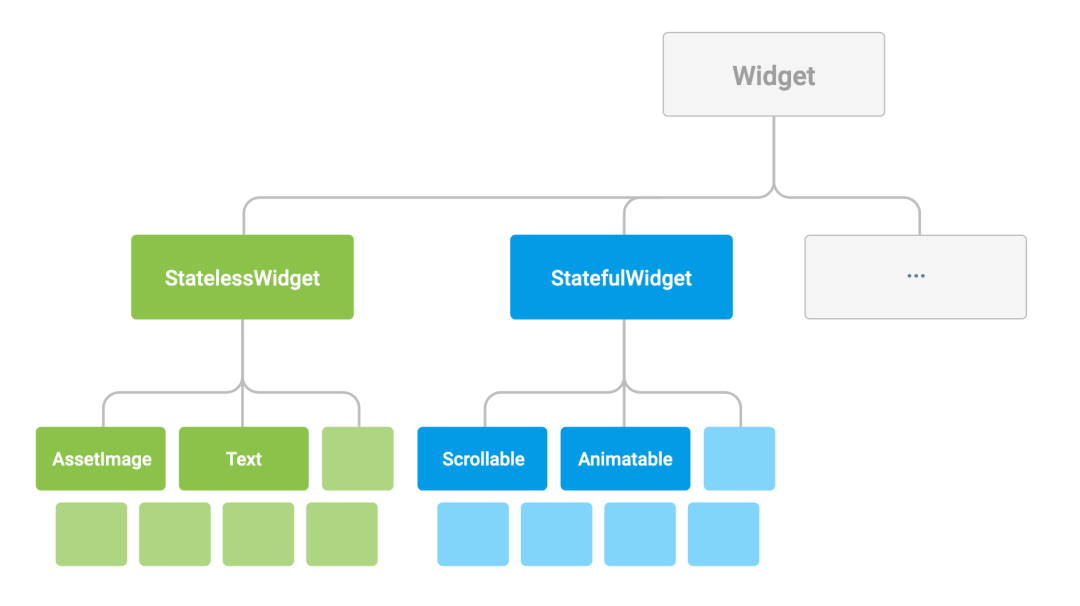
Widget 布局
上说过 Flutter 布局思路来自 CSS,而 Flutter 中一切皆 Widget,因此整体布局也很简单:
- 容器组件 Container
- decoration 装饰属性,设置背景色,背景图,边框,圆角,阴影和渐变等
- margin
- padding
- alignment
- width
- height
- Padding,Center
- Row,Column,Flex
- Wrap, Flow 流式布局
- Stack, Z 轴布局
- ……
Flutter 中 Widget 可以分为三类,形如 React 中“展示组件”、“容器组件”,“context”。
StatelessWidget
这个就是 Flutter 中的“展示组件”,自身不保存状态,外部参数变化就销毁重新创建。Flutter 建议尽量使用无状态的组件。
StatefulWidget
状态组件就是类似于 React 中的“容器组件”了,Flutter 中状态组件写法会稍微不一样。
- class Counter extends StatefulWidget {
- // This class is the configuration for the state. It holds the
- // values (in this case nothing) provided by the parent and used by the build
- // method of the State. Fields in a Widget subclass are always marked "final".
- @override
- _CounterState createState() => _CounterState();
- }
- class _CounterState extends State<Counter> {
- int _counter = 0;
- void _increment() {
- setState(() {
- // This call to setState tells the Flutter framework that
- // something has changed in this State, which causes it to rerun
- // the build method below so that the display can reflect the
- // updated values. If you change _counter without calling
- // setState(), then the build method won't be called again,
- // and so nothing would appear to happen.
- _counter++;
- });
- }
- @override
- Widget build(BuildContext context) {
- // This method is rerun every time setState is called, for instance
- // as done by the _increment method above.
- // The Flutter framework has been optimized to make rerunning
- // build methods fast, so that you can just rebuild anything that
- // needs updating rather than having to individually change
- // instances of widgets.
- return Row(
- children: <Widget>[
- RaisedButton(
- onPressed: _increment,
- child: Text('Increment'),
- ),
- Text('Count: $_counter'),
- ],
- );
- }
- }
可以看到 Flutter 中直接使用了和 React 中同名的setState方法,不过不会有变量合并的东西,当然也有生命周期。
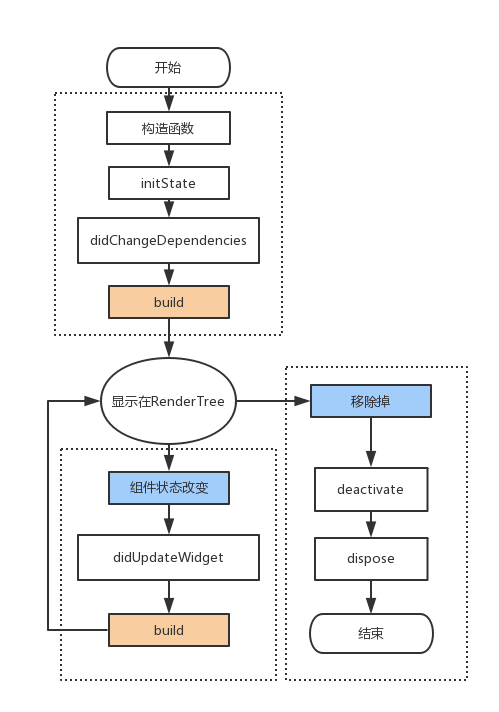
可以看到一个有状态的组件需要两个 Class,这样写的原因在于,Flutter 中 Widget 都是 immmutable 的,状态组件的状态保存在 State 中,组件仍然每次重新创建,Widget 在这里只是一种对组件的描述,Flutter 会 diff 转换成 Element,然后转换成 RenderObject 才渲染。
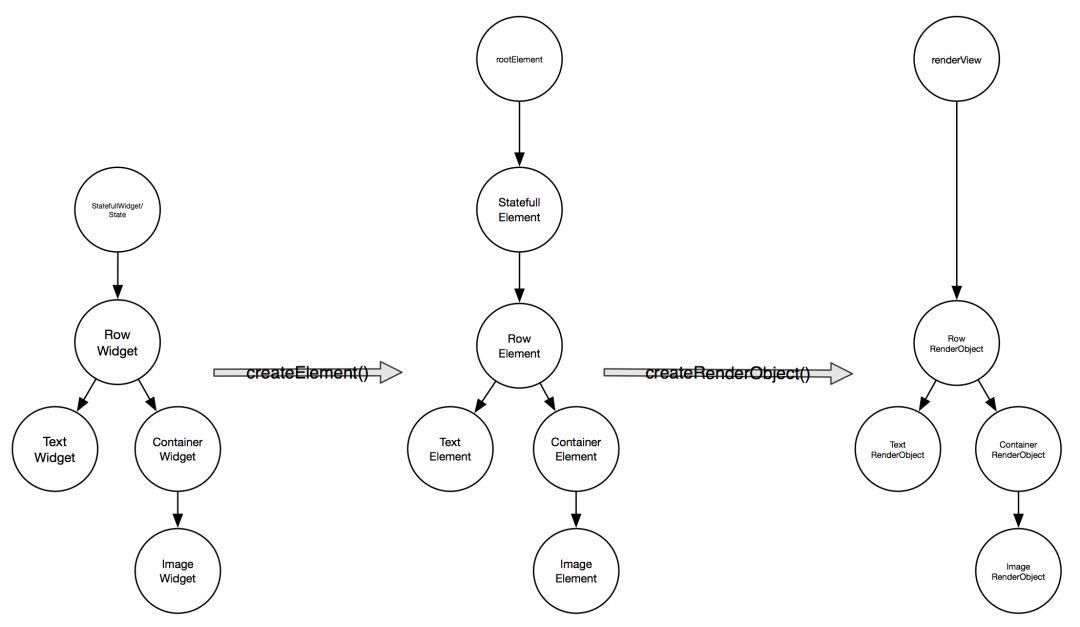
Flutter Widget 更多的渲染流程可以看这里。
实际上 Widget 只是作为组件结构一种描述,还可以带来的好处是,你可以更方便的做一些主题性的组件, Flutter 官方提供的Material Components widgets和Cupertino (iOS-style) widgets质量就相当高,再配合 Flutter 亚秒级的Hot Reload,开发体验可以说挺不错的。
State Management
setState()可以很方便的管理组件内的数据,但是 Flutter 中状态同样是从上往下流转的,因此也会遇到和 React 中同样的问题,如果组件树太深,逐层状态创建就显得很麻烦了,更不要说代码的易读和易维护性了。
InheritedWidget
同样 Flutter 也有个context一样的东西,那就是InheritedWidget,使用起来也很简单。
- class GlobalData extends InheritedWidget {
- final int count;
- GlobalData({Key key, this.count,Widget child}):super(key:key,child:child);
- @override
- bool updateShouldNotify(GlobalData oldWidget) {
- return oldWidget.count != count;
- }
- static GlobalData of(BuildContext context) => context.inheritFromWidgetOfExactType(GlobalData);
- }
- class MyApp extends StatelessWidget {
- // This widget is the root of your application.
- @override
- Widget build(BuildContext context) {
- return MaterialApp(
- title: 'Flutter Demo',
- theme: ThemeData(
- primarySwatch: Colors.blue,
- ),
- home: MyHomePage(title: 'Flutter Demo Home Page'),
- );
- }
- }
- class MyHomePage extends StatefulWidget {
- MyHomePage({Key key, this.title}) : super(key: key);
- final String title;
- @override
- _MyHomePageState createState() => _MyHomePageState();
- }
- class _MyHomePageState extends State<MyHomePage> {
- int _counter = 0;
- void _incrementCounter() {
- _counter++;
- });
- }
- @override
- Widget build(BuildContext context) {
- return Scaffold(
- appBar: AppBar(
- title: Text(widget.title),
- ),
- body: GlobalData(
- count: _counter,
- child: Center(
- child: Column(
- mainAxisAlignment: MainAxisAlignment.center,
- children: <Widget>[
- Text(
- 'You have pushed the button this many times:',
- ),
- Text(
- '$_counter',
- style: Theme.of(context).textTheme.display1,
- ),
- Body(),
- Body2()
- ],
- ),
- ),
- ),
- floatingActionButton: FloatingActionButton(
- onPressed: _incrementCounter,
- tooltip: 'Increment',
- child: Icon(Icons.add),
- ),
- );
- }
- }
- class Body extends StatelessWidget {
- @override
- Widget build(BuildContext context) {
- GlobalData globalData = GlobalData.of(context);
- return Text(globalData.count.toString());
- }
- }
- class Body2 extends StatelessWidget {
- @override
- Widget build(BuildContext context) {
- // TODO: implement build
- GlobalData globalData = GlobalData.of(context);
- return Text(globalData.count.toString());
- }
具体实现原理可以参考这里,不过 Google 封装了一个更为上层的库provider,具体使用可以看这里。
BlOC
BlOC是 Flutter team 提出建议的另一种更高级的数据组织方式,也是我最中意的方式。简单来说:
Bloc = InheritedWidget + RxDart(Stream)
Dart 语言中内置了 Steam,Stream ~= Observable,配合RxDart, 然后加上StreamBuilder会是一种异常强大和自由的模式。
- class GlobalData extends InheritedWidget {
- final int count;
- final Stream<String> timeInterval$ = new Stream.periodic(Duration(seconds: 10)).map((time) => new DateTime.now().toString());
- GlobalData({Key key, this.count,Widget child}):super(key:key,child:child);
- @override
- bool updateShouldNotify(GlobalData oldWidget) {
- return oldWidget.count != count;
- }
- static GlobalData of(BuildContext context) => context.inheritFromWidgetOfExactType(GlobalData);
- }
- class TimerView extends StatelessWidget {
- @override
- Widget build(BuildContext context) {
- GlobalData globalData = GlobalData.of(context);
- return StreamBuilder(
- stream: globalData.timeInterval$,
- builder: (context, snapshot) {
- return Text(snapshot?.data ?? '');
- }
- );
- }
- }
当然 Bloc 的问题在于
- 学习成本略高,Rx 的概念要吃透,不然你会抓狂
- 自由带来的问题是,可能代码不如 Redux 类的规整。
顺便,今年 Apple 也拥抱了响应式,Combine(Rx like) + SwiftUI 也基本等于 Bloc 了。
所以,Rx 还是要赶紧学起来 😬
除去 Bloc,Flutter 中还是可以使用其他的方案,譬如:
- Flutter Redux
- 阿里闲鱼的Fish Redux,据说性能很好。
- Mobx
- ……
展开来说现在的前端开发使用强大的框架页面组装已经不是难点了。开发的难点在于如何组合富交互所需的数据,也就是上面图中的state部分。
更具体来说,是怎么优雅,高效,易维护地处理短暂数据(ephemeral state)setState()和需要共享的 App State 的问题,这是个工程性的问题,但往往也是日常开发最难的事情了,引用 Redux 作者 Dan 的一句:
“The rule of thumb is:Do whatever is less awkward.”
到这里,主要的部分已经讲完了,有这些已经可以开发出一个不错的 App 了。剩下的就当成一个 bonus 吧。
测试
Flutter debugger,测试都是出场自带,用起来也不难。
- // 测试在/test/目录下面
- void main() {
- testWidgets('Counter increments smoke test', (WidgetTester tester) async {
- // Build our app and trigger a frame.
- await tester.pumpWidget(MyApp());
- // Verify that our counter starts at 0.
- expect(find.text('0'), findsOneWidget);
- expect(find.text('1'), findsNothing);
- // Tap the '+' icon and trigger a frame.
- await tester.tap(find.byIcon(Icons.add));
- await tester.pump();
- // Verify that our counter has incremented.
- expect(find.text('0'), findsNothing);
- expect(find.text('1'), findsOneWidget);
- });
- }
包管理,资源管理
类似与 JavaScript 的 npm,Flutter,也就是 Dart 也有自己的包仓库。不过项目包的依赖使用 yaml 文件来描述:
- name: app
- description: A new Flutter project.
- version: 1.0.0+1
- environment:
- sdk: ">=2.1.0 <3.0.0"
- dependencies:
- flutter:
- sdk: flutter
- cupertino_icons: ^0.1.2
生命周期
移动应用总归需要应用级别的生命周期,flutter 中使用生命周期钩子,也非常的简单:
- class MyApp extends StatefulWidget {
- @override
- _MyAppState createState() => new _MyAppState();
- }
- class _MyAppState extends State<MyApp> with WidgetsBindingObserver {
- @override
- void initState() {
- super.initState();
- WidgetsBinding.instance.addObserver(this);
- }
- @override
- void dispose() {
- WidgetsBinding.instance.removeObserver(this);
- super.dispose();
- }
- @override
- void didChangeAppLifecycleState(AppLifecycleState state) {
- switch (state) {
- case AppLifecycleState.inactive:
- print('AppLifecycleState.inactive');
- break;
- case AppLifecycleState.paused:
- print('AppLifecycleState.paused');
- break;
- case AppLifecycleState.resumed:
- print('AppLifecycleState.resumed');
- break;
- case AppLifecycleState.suspending:
- print('AppLifecycleState.suspending');
- break;
- }
- super.didChangeAppLifecycleState(state);
- }
- @override
- Widget build(BuildContext context) {
- return Container();
- }
- }
使用原生能力
和 ReactNative 类似,Flutter 也是使用类似事件的机制来使用平台相关能力。
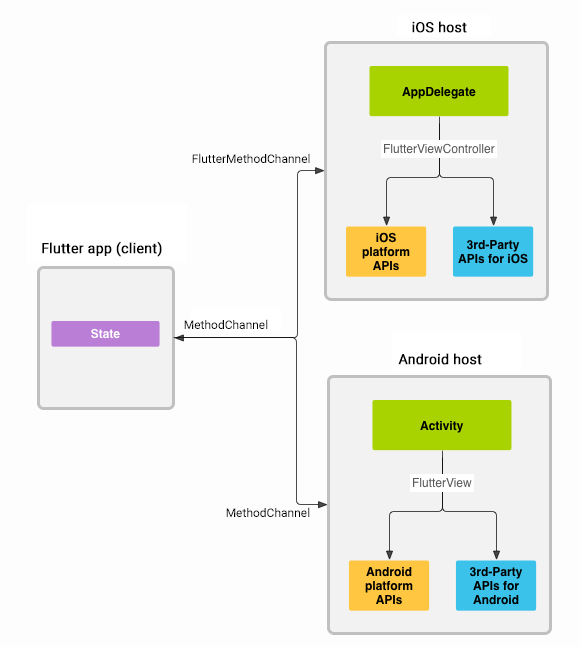
Flutter Web, Flutter Desktop
这些还在开发当中,鉴于对 Dart 喜欢,以及对 Flutter 性能的乐观,这些倒是很值得期待。
